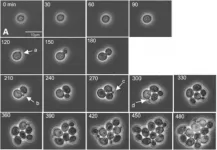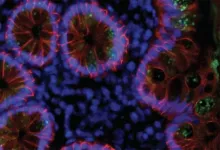Study updates breast cancer risk estimates for women with no family history
2021-01-21
(Press-News.org) ROCHESTER, Minnesota -- A new multi-institution study led by Fergus Couch, Ph.D., a Mayo Clinic pathologist, provides more accurate estimates of breast cancer risk for U.S. women who harbor inherited mutations in breast cancer predisposition genes. The findings of the CARRIERS Consortium study, which were published Wednesday, Jan. 20 in the New England Journal of Medicine, may allow health care providers to better assess the risk of breast cancer in women ? many of whom have no family history of breast cancer ? and provide more appropriate risk management strategies.
"Traditionally, genetic testing of inherited breast cancer genes has focused on women at high risk who have a strong family history of breast cancer or those who were diagnosed at an early age, such as under 45 years," says Dr. Couch. He says current estimates of breast cancer risk provided to women when they are found to have a breast cancer mutation are actually appropriate only for those who are at high risk and not for women from the general population.
In the CARRIERS Consortium study, researchers conducted hereditary cancer genetic testing of 12 established breast cancer genes in 32,247 women with breast cancer and 32,544 women of similar ages without breast cancer from several large U.S. population-based studies. By analyzing women from these population-based studies, researchers were able to better understand how frequent mutations were among the various breast cancer genes and more accurately estimate the risk of developing breast cancer for women in the general population with mutations in those genes.
"The risk of developing breast cancer is generally lower for women without a family history of the disease" says Dr. Couch. "When we looked at all women, we found that 30% of breast cancer mutations occurred in women who are not high-risk." Dr. Couch says that before this study, these women were not able to receive accurate estimates of their breast cancer risk. He also noted that these findings were similar for white, black and Hispanic women.
Dr. Couch anticipates that breast cancer clinics will use the new risk estimates to provide more accurate risk assessments for women who don't have a family history of breast cancer.
INFORMATION:
About the CARRIERS Consortium
The CARRIERS consortium is a group of 17 large epidemiology studies in the U.S. focused on women in the general population who develop breast cancer. CARRIERS aims to improve understanding of genetic and environmental risk factors for breast cancer using information from the participants in these studies. CARRIERS is supported by National Institutes of Health grants R01CA192393 and R35CA253187, and the Breast Cancer Research Foundation.
About Mayo Clinic
Mayo Clinic is a nonprofit organization committed to innovation in clinical practice, education and research, and providing compassion, expertise and answers to everyone who needs healing. Visit the Mayo Clinic News Network for additional Mayo Clinic news and Mayo Clinic Facts for more information about Mayo.
ELSE PRESS RELEASES FROM THIS DATE:
2021-01-21
HOUSTON -- Researchers from The University of Texas MD Anderson Cancer Center have developed the first comprehensive framework to classify small-cell lung cancer (SCLC) into four unique subtypes, based on gene expression, and have identified potential therapeutic targets for each type in a study published today in Cancer Cell.
SCLC is known for rapid, aggressive growth and resistance to treatment, which leads to poor outcomes. While recent advances in immunotherapy and targeted therapy have improved survival for non-small cell lung cancer (NSCLC), progress for SCLC has been limited.
"For decades, small-cell lung cancer has been treated as a single disease because the tumors all ...
2021-01-21
Older people in Japan have an "attitude of gratitude" which keeps them feeling hopeful despite the challenges of aging, a new study says.
Feeling thankful and grateful for the care and support they have had during their life helps pensioners in the country to be more optimistic, even when they experienced difficulties and were anxious about getting older, an expert found.
Dr Iza Kavedžija, from the University of Exeter, observed people in their 80s and 90s in the course of long-term ethnographic fieldwork in a merchant neighbourhood in the city of Osaka. Her research is published in the journal Anthropology and Aging.
Dr Kavedžija found many members of ...
2021-01-21
Once regarded as merely cast-off waste products of cellular life, bacterial membrane vesicles (MVs) have since become an exciting new avenue of research, due to the wealth of biological information they carry to other bacteria as well as other cell types.
These tiny particles, produced by most bacteria, can bud off from outer cellular membranes, traveling along cell surfaces and occasionally migrating into intercellular spaces.Luis Cisneros is a researcher in the Biodesign Center for Biocomputing, Security and Society, and the BEYOND Center for Fundamental Concepts in Science, at Arizona state University.
In a new study, Luis H. Cisneros and his colleagues describe ...
2021-01-21
DURHAM, N.C. -- Researchers at Duke University have developed a predictive theory for tumor growth that approaches the subject from a new point of view. Rather than focusing on the biological mechanisms of cellular growth, the researchers instead use thermodynamics and the physical space the tumor is expanding into to predict its evolution from a single cell to a complex cancerous mass.
The results appeared Jan. 15 in the journal Biosystems.
"When scientists think about cancer, the first thing that comes to mind is biology, and they tend to overlook the physical reality of ...
2021-01-21
Indigenous peoples' lands may harbour a significant proportion of threatened and endangered species globally, according to University of Queensland-led research.
UQ's Dr Chris O'Bryan and his team conducted the first comprehensive analysis of land mammal composition across mapped Indigenous lands.
"These lands cover more than one-quarter of the Earth, of which a significant proportion is still free from industrial-level human impacts," Dr O'Bryan said.
"As a result, Indigenous peoples and their lands are crucial for the long-term persistence of the planet's biodiversity and ecosystem services.
"Despite this, we know relatively little about what animals, including highly imperilled species, may reside in or depend on these lands."
The team overlayed maps of Indigenous ...
2021-01-21
ITHACA, N.Y. - Far below the gaseous atmospheric shroud on Saturn's largest moon, Titan, lies Kraken Mare, a sea of liquid methane. Cornell University astronomers have estimated that sea to be at least 1,000-feet deep near its center - enough room for a potential robotic submarine to explore.
After sifting through data from one of the final Titan flybys of the Cassini mission, the researchers detailed their findings in "The Bathymetry of Moray Sinus at Titan's Kraken Mare," which published in the Journal of Geophysical Research.
"The depth and composition of each of Titan's seas had already been measured, ...
2021-01-21
University of Illinois Chicago is one of the U.S. sites participating in clinical trials to cure severe red blood congenital diseases such as sickle cell anemia or Thalassemia by safely modifying the DNA of patients' blood cells.
The first cases treated with this approach were recently published in an article co-authored by Dr. Damiano Rondelli, the Michael Reese Professor of Hematology at the UIC College of Medicine. The article reports two patients have been cured of beta thalassemia and sickle cell disease after their own genes were edited with CRISPR-Cas9 technology. The two researchers ...
2021-01-21
New research from McMaster University has found that psychiatric help for mothers with postpartum depression results in healthy changes in the brains of their babies.
The study, published in the journal Depression and Anxiety this week, found treating mothers who had postpartum depression with cognitive behavioural therapy (CBT) not only helped the moms, but resulted in adaptive changes in the brains and behaviour of their infants.
More specifically, after the mothers' treatment, their infants showed healthy changes in their nervous and cardiovascular systems, and they were observed to better regulate their behaviours and emotions by both mothers and fathers.
"In fact, we found that after their moms were treated that their infant's ...
2021-01-21
As the number of people who have fought off SARS-CoV-2 climbs ever higher, a critical question has grown in importance: How long will their immunity to the novel coronavirus last? A new Rockefeller study offers an encouraging answer, suggesting that those who recover from COVID-19 are protected against the virus for at least six months, and likely much longer.
The findings, published in Nature, provide the strongest evidence yet that the immune system "remembers" the virus and, remarkably, continues to improve the quality of antibodies even after the infection has waned. Antibodies produced ...
2021-01-21
BIRMINGHAM, Ala. - University of Alabama at Birmingham polymer and radionuclide chemists report what they say "may represent a major step forward in microcapsule drug delivery systems."
The UAB microcapsules -- labeled with radioactive zirconium-89 -- are the first example of hollow polymer capsules capable of long-term, multiday positron emission tomography, or PET, imaging in vivo. In previous work, UAB researchers showed that the hollow capsules could be filled with a potent dose of the cancer drug doxorubicin, which could then be released by therapeutic ultrasound that ruptures the microcapsules.
PET imaging with zirconium-89 -- which has a half-life of 3.3 days -- allowed the capsules to be traced in test mice up to seven days. The major ...
LAST 30 PRESS RELEASES:
[Press-News.org] Study updates breast cancer risk estimates for women with no family history





